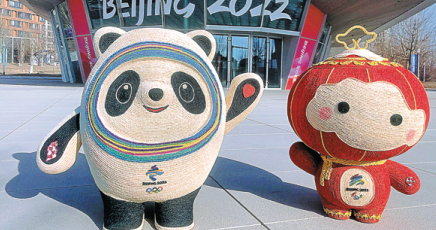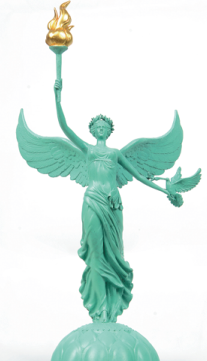Artistic endeavors add local color to Games
Updated: 2022-02-11

Two straw-knitted Winter Games mascots, which were made by Shanxi's artists, stand at the entrance of the main media center. [Photo by Liu Jiang for China Daily]
Artists in Shanxi have contributed to the ongoing 2022 Beijing Winter Olympic Games by designing artworks for the sports gala.
One of the most remarkable creations by Shanxi's artists was a group of bronze sculptures called Olympic Flame.
During the Olympic flame-collecting ceremony in Greece on Oct 18, Yu Zaiqing, vice-president of the International Olympic Committee and vice-president of the Beijing Organizing Committee for the 2022 Olympic and Paralympic Winter Games, brought the sculptures as national gifts to Greek and IOC officials.
They included Greek President Katerina Sakellaropoulou, IOC President Thomas Bach, Hellenic Olympic Committee President Spyros Capralos and Mayor of Ancient Olympia Georgios Georgiopoulos.
The sculpture, featuring a goddess of victory and peace raising a lit torch in her right hand and holding in her left hand a pigeon with an olive branch in its beak, was created by renowned sculptor Huang Jian and produced by Yuda Bronze Culture and Art based in the southern Shanxi city of Yuncheng.
The sculpture stands on a marble foundation, which has the inscription "Faster, Higher, Stronger, Together", the new Olympic motto proposed by IOC President Bach. Beneath the motto is the inscription "Carry on the Olympic Flame to Illuminate a Bright Future", showing Shanxi people's best wishes to the Winter Olympic Games.

The Olympic Flame sculpture created by Huang Jian. [Photo by Dong Xinhui for China Daily]
According to Wei Enke, board chairman of Yuda Bronze Culture and Art, the sculpture also functions as a bridge connecting the ancient societies of China and Greece, and the ancient and modern Olympics.
"The sculpture features elements of both China and Greece, of both the ancient and modern," Wei said.
These elements include the images of the Great Wall and Olympia Mountains, the ancient Greek arena and the Bird's Nest stadium-the main venue for the Beijing 2008 Olympics-as well as lotus leaf and olive branch patterns.
In addition to the Olympic Flame, Yuda has also manufactured a set of bronze ritual vessels called the Zun of Olympics. Zun was a kind of sacrificial vessel in ancient China more than 2,000 years ago.
"Designed by famed Chinese handicraft master Sun Hong, the Zun of Olympics is now exhibited at the Beijing Olympics Museum," Wei said.
Another artwork that Shanxi presented to the Beijing Winter Olympics was the Winter Olympic Flame sword. It was designed and crafted by Liu Wentao, the sixth-generation successor of the intangible cultural heritage of ancient sword manufacturing.
"In China, a sword is a symbol of victory," Liu said. "I hope this sword can bring good luck to all athletes competing in the Games."
The artist said the sword incorporates both ancient Chinese and Olympic cultural elements, which include the Olympic flame and medal patterns on its handle. The body is manufactured using Tang Dynasty (618-907) forging techniques and the sheath is made with a Han Dynasty (206 BC-AD 220) lacquer technique.
In addition, Shanxi's folk artists have created their own version of Bing Dwen Dwen and Shuey Rhon Rhon, the mascots of the Games.
The mascots in Shanxi version, exhibited at the main media center of the 2022 Beijing Winter Olympic Games, are knitted with straw by six artists in the city of Linfen.
Guo Suqin, one of the artists, said she was proud of a detail during the making of the mascots.
"We have put a map of Shanxi in the right hand of the mascots as an ornament," Guo said. "We hope this can help our friends from across the world better understand Shanxi."
Guo Yanjie contributed to this story.



